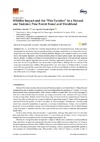Please use this identifier to cite or link to this item:
http://hdl.handle.net/10553/55511
| DC Field | Value | Language |
|---|---|---|
| dc.contributor.author | Arévalo, José Ramón | en_US |
| dc.contributor.author | Naranjo Cigala, Agustín | en_US |
| dc.date.accessioned | 2019-05-28T09:20:48Z | - |
| dc.date.available | 2019-05-28T09:20:48Z | - |
| dc.date.issued | 2018 | en_US |
| dc.identifier.issn | 2571-6255 | en_US |
| dc.identifier.uri | http://hdl.handle.net/10553/55511 | - |
| dc.description.abstract | Fire is a powerful force that has shaped forests for thousands of years. It also provokes widespread social concern due to possible economic damage, social effects, impact on homes and properties, and other social effects including fatalities. Regions with seasonal variations in aridity have a fire regime dependent on climate resulting from the role of precipitation and temperature in fire occurrence, implying a synchrony of fire occurrence at regional scale. This spatial and temporal variation of fire regimes regulates the structure, diversity, regeneration dynamics, and nutrient cycle of an area. In the Canary Islands, fires are recurrent in pine forests, although their occurrence in the same area more than once within a 20-year period is rare. The main aim of this work is to reveal, over a 50-year period, fire occurrence and impact on the Canary Islands and how the islands are immersed in a “fire paradox”—a process typical of protected areas, where fire suppression becomes one of the main aims of forest management. | en_US |
| dc.language | eng | en_US |
| dc.relation.ispartof | Fire (Basel) | en_US |
| dc.source | Fire (Basel) [ISSN:2571-6255], v.1 (3), p. 44 | en_US |
| dc.subject | 2417 Biología vegetal (botánica) | en_US |
| dc.subject.other | Canary Islands | en_US |
| dc.subject.other | Fire paradox | en_US |
| dc.subject.other | Fire suppression | en_US |
| dc.subject.other | Pinus canariensis forests | en_US |
| dc.title | Wildfire impact and the "Fire Paradox" in a natural and endemic pine forest stand and shrubland | en_US |
| dc.type | info:eu-repo/semantics/article | es |
| dc.type | Article | es |
| dc.identifier.doi | 10.3390/fire1030044 | en_US |
| dc.description.lastpage | 44 | - |
| dc.identifier.issue | 3 | - |
| dc.description.firstpage | 44 | - |
| dc.relation.volume | 1 | - |
| dc.investigacion | Ciencias | en_US |
| dc.type2 | Artículo | en_US |
| dc.identifier.ulpgc | Sí | es |
| item.grantfulltext | open | - |
| item.fulltext | Con texto completo | - |
| crisitem.author.dept | GIR IUNAT: Biología Integrativa y Recursos Biológicos | - |
| crisitem.author.dept | IU de Estudios Ambientales y Recursos Naturales | - |
| crisitem.author.dept | Departamento de Geografía | - |
| crisitem.author.orcid | 0000-0001-8191-7344 | - |
| crisitem.author.parentorg | IU de Estudios Ambientales y Recursos Naturales | - |
| crisitem.author.fullName | Naranjo Cigala, Agustín | - |
| Appears in Collections: | Artículos | |
WEB OF SCIENCETM
Citations
14
checked on Mar 30, 2025
Page view(s)
72
checked on Aug 19, 2023
Download(s)
76
checked on Aug 19, 2023
Google ScholarTM
Check
Altmetric
Share
Export metadata
Items in accedaCRIS are protected by copyright, with all rights reserved, unless otherwise indicated.
